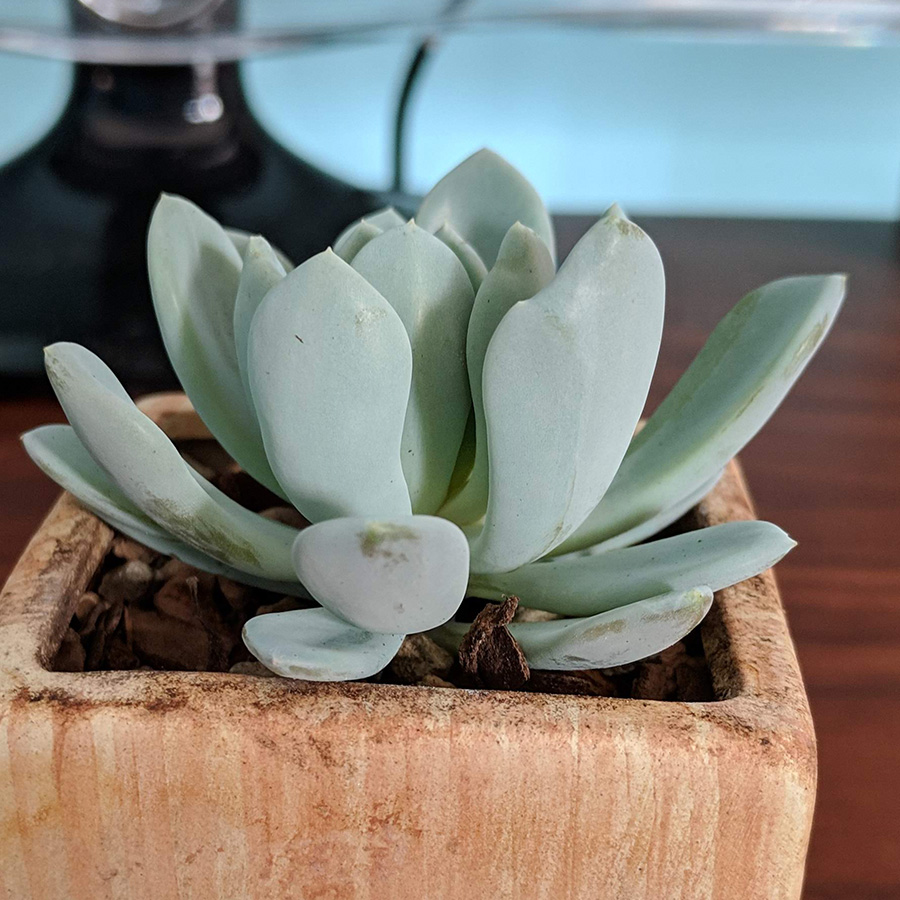Meet Succulents: Why I love them and why they might be your new friends too
- Aria Gardens

- Dec 29, 2024
- 7 min read
Winter is here, our gardens are fast asleep, and we settle into the slower rhythm of winter. It can be restorative to enjoy the quiet after the frenzy, but I know that for me (and perhaps for some of you?) that tranquility won’t last long. Soon enough, we’ll find ourselves craving something green and growing to nurture indoors. If, like me, you get antsy and start itching for a new plant friend, let me make a formal introduction. Meet succulents: some of the coolest plants you’ll ever encounter.

Succulents are fascinating. These fleshy plants hail from arid regions and have adapted to thrive with infrequent and inconsistent water. Their thick stems and leaves act as built-in reservoirs. If camels were plants, they’d be succulents. This structure allows them to store water, holding them over until the next chance to drink. You’ve likely spotted them at garden centres or seen their striking shapes and colors featured in trendy arrangements. In suitable climates, they’re used beautifully in water-conscious landscaping.
But here’s the thing: succulents come with a reputation for being “impossible to kill.” Nevertheless I often hear people share stories of their attempts to grow these plants, followed by a confession of frustration or even embarrassment when it didn’t end well. The reality is succulents are trickier to satisfy than their reputation suggests. With the right care, they’re wonderfully low-maintenance, but it’s not hard to accidentally kill them, either. My goal is to help you understand what they need so you can embrace these resilient plants with renewed confidence, and maybe even a little awe.
What’s so cool about succulents
Succulents are incredible, and you’ll never find a better “go with the flow” kind of plant. Their adaptations don’t just help them survive in tough conditions, but also make them unusually easy to multiply. These plants are pros at turning a little into a lot!
Here’s how it works: cut across the stem of a succulent, let the cut dry and seal, and the cutting will grow its own roots, becoming a brand-new plant. Meanwhile, the original plant doesn’t miss a beat. It keeps growing, sending out fresh shoots from the cut site or even sprouting new growth from leaf nodes.
Some varieties are even more independent. Any fallen leaf marks a possible new beginning. A new plant can sprout from the base of that leaf, no intervention needed. All they really want is to be left alone to do their thing. Still others will grow “pups” to the side of the base of a parent plant.
Why are such “easy” plants so hard for plant lovers?
Succulents may have a reputation for being “impossible to kill,” but for plant lovers, especially those with houseplant experience, they can be surprisingly tricky. The very instincts that make you great with other plants, like regular watering, rich soil, and attentive care, can backfire when it comes to succulents. Here’s why:
They Thrive on Neglect: Overwatering is their number one enemy. Succulents want their soil bone dry before they see water again. Waterlogged roots are an open invitation for rot, and once it sets in, it’s hard to stop.
Moisture Sensitivity: Succulents need soil that drains quickly, often resembling gravel more than dirt. Standard potting mixes are designed to hold water, making it easy to drown succulent roots.
Light Demands: Most succulents love long hours of bright, direct sunlight. While some manage in moderate light, they all want way more than we expect. Without it, they start to “stretch,” growing taller with thin stems, smaller leaves, and more muted colours, on their quest for better light.
Patience Required: Succulents take their time. They’ve evolved to grow slowly, conserving energy and resources in their harsh native environments. While this means less upkeep for you, it can feel disheartening if you’re expecting rapid changes.
Do You Want In? Set Yourself Up for Success
Starting a succulent collection can feel overwhelming, but it doesn’t have to be. The key is figuring out what works for you. Whether you want a thriving display right away or prefer to grow your plants slowly over time, your choices will depend on factors like budget, time, and how involved you want to be. Here’s a breakdown to help you plan:
1. Budget
Small Plants or Cuttings: Starting small is affordable, with tiny potted succulents each costing $3–$5 or an assortment of cuttings for $15–$30. Cuttings require more patience but are perfect if you’re aiming to grow a collection over time.

Unboxed rosette and mixed cutting orders from Etsy. Larger Plants or Collections: If you want an immediate display, mid-sized potted plants give instant impact but can add up quickly. A larger succulent might cost $20–$50, while rare varieties or big specimens can climb into the hundreds.
Guiding Question: How much are you comfortable investing upfront? Would you prefer a few showpiece plants or a long-term project growing cuttings?
2. Patience
Fast Results: Small potted succulents are the quickest way to enjoy a thriving plant. They’re ready to water and display as soon as you bring them home.
Slow and Steady: Starting from leaves is the slowest option but can be incredibly rewarding. Prepare to wait weeks for roots to appear and a couple months for full new plants. This can also be a low-effort background project that gradually rewards your patience.
A Middle Ground: Cuttings are a perfect compromise. They don’t require much attention beyond potting for the first time. They look like full plants right away, but their focus will be on growing roots for the first few weeks so don’t expect new growth right away.
Guiding Question: Do you enjoy watching slow progress, or do you prefer immediate gratification?
3. Activity Level

Hands-On: If you like to “play” with your plants by repotting, watering, or arranging them, choose smaller pots or a variety of plants. Smaller pots dry out faster, so you’ll have more frequent tasks.
Hands-Off: If you want something low-maintenance, opt for larger pots, crowded arrangements, or growing from leaves. Crowded plants grow slower, so they’ll need less frequent watering and upkeep. For arrangements, choosing cuttings over rooted plants will keep plants stable while they grow roots.
Guiding Question: Do you want to be hands-on with your plants or enjoy a more laid-back approach?
4. Light Availability
Bright Light: With a sunny south-facing window and grow lights, you can choose any succulent species and expect them to thrive. Plants like Echeveria and Sedum will reward you with vibrant colours and dense, compact growth.
Low Light: If natural light is limited, consider species like Snake Plants or Haworthias. These tolerate indirect light well, though they won’t grow as quickly or vibrantly.
Guiding Question: How much light can you provide? Do you need low-light options or have space for sun-loving varieties?
5. Location
Where you live matters for where you’ll find succulents and how you’ll care for them:
Local Nurseries and Shops: Here’s the opportunity to support local businesses. In Calgary, local garden centres are a great option, as are some small plant shops (I love Plant Plant in Inglewood). You’ll find well-cared-for plants that are ready to thrive.
Online Shopping: For more variety and plant forms, check Etsy or online Canadian succulent retailers. Just be cautious about winter shipping and plan to pay for a heat pack to protect your plants from the cold.
Safety Tip: Keep succulents out of reach of pets and check their toxicity before bringing them home. Some varieties can be harmful to cats and dogs.
Guiding Question: Do you prefer picking plants in person or browsing unique options online?
Putting It All Together
Once you’ve considered your preferences, you’ll have a clearer idea of how to start your collection. If you’re not sure where to begin, try picking up a few small plants locally. Jade (Crassula) and Haworthia are fantastic starters, or, if you have plenty of light, an Echeveria or Sedum. These plants are forgiving and will help you build confidence as you grow your succulent family. If you’d like a little guidance as you get started, I want to help! Feel free to reach out with questions or share your plans. I’m always excited to talk plants and help fellow gardeners find their footing with succulents.
Recommendations for getting started
Start Small: Begin with one or two plants to get a feel for their needs. Popular beginner options include Jade, Haworthia, and, if you have plenty of light, Echeveria or Sedum.
Use the Right Tools: Make sure your pots have drainage holes, and use a fast-draining succulent soil mix to prevent waterlogging.
Water Sparingly: Resist the urge to water immediately after bringing your plant home. Wait until the pot feels feather-light when you pick it up before giving it a good soak. Avoid getting water on the leaves or stems to prevent rot.
Place ‘em! Succulents thrive in bright, direct sunlight, so give them the sunniest spot in your home. Keep new plants separate for a couple of weeks as a precaution to avoid exposing your current plants to unwanted pests.
Experiment with Propagation: If you’re feeling adventurous, try propagating a few leaves or cuttings. This is a low-pressure way to multiply your collection over time.
Starting small and focusing on the basics will help you build confidence and enjoy your new plant friends. As you gain experience, you’ll likely find yourself wanting to explore even more varieties and techniques!
Feel the Gratification
I cannot recommend enough that you take consistent photos of your plants. Succulents grow slowly, and their changes are often so subtle they’re hard to see day to day. Progress photos are your secret weapon! Comparing new snapshots to past ones will reveal the growth you’ve nurtured. It’s the easiest way to know you’re on the right track and to feel rewarded for your care.

Once you’ve gained a little practice and comfort, I wouldn’t be surprised if you feel the draw to expand your collection and deepen your passion. If you have questions, need guidance, or want to share your photos and progress, I’d love to hear from you! Nothing makes me happier than celebrating your gardening wins with you.
Hey there! Hooked yet? I plan to dive deeper into succulent care and propagation in future posts, with tips to help you take your collection to the next level. If you’d like to stay in the loop, consider subscribing to be notified when new posts are live!












Comments